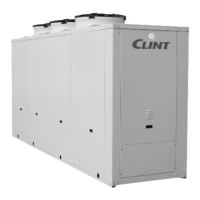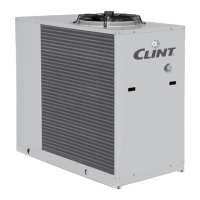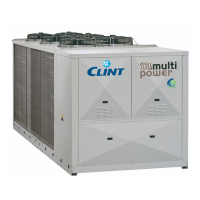23
- Po kilku godzinach pracy, sprawdź czy wziernik wskaź-
nika cieczy i wilgotności wskazuje na suchy układ.
- Upewnij się, że przez wziernik cieczy nie widać pęche-
rzyków powietrza. Pęcherzyki wskazują na niedosta-
teczną ilość ciekłego czynnika w układzie (jednak nie-
wielka ich ilość jest dopuszczalna).
Kontroli tej można dokonać na podstawie do-
łączonych manometrów (w przypadku ich
zamontowania). W takim przypadku, pamiętaj
o zamknięciu zaworów odcinających (w przy-
padku ich zastosowania) po wykonaniu po-
miarów.
6.3 CHECKS DURING UNIT OPERATION
6.3.1 General
- Check the unit for strange sounds or excessive vibra-
tions.
- Check that the above sequence is repeated regu-
larly, leaving each compressor working for at least
10 minutes (if this is not the case, unit inertia must be
increases).
- After a few operating hours, check that the crown of
the liquid and moisture indicator shows a dry circuit.
- Make sure there are no bubbles inside the liquid
indicator. Bubbles indicate there is not enough refrig-
erant liquid in the circuit (though a few bubbles are
accepted).
- A few minutes after the compressors start during the
summer operating cycle, make sure the condensation
temperature is 18 ± 4K higher than the temperature
of the air entering the condenser (depending on the
size of the chiller, the kind of refrigerant gas used
and the room temperature) and that the evaporating
temperature is about 5K less than the temperature of
the water leaving the evaporator.
- Make sure that the overheating temperature of the re-
frigerant lies between 5 and 7K. Do this by measuring
the temperature with a contact thermometer placed on
the suction pipe of the compressor and that indicated
on a pressure gauge connected to the suction line as
well: the difference between the two gives the values
of overheating.
- Make sure that the subcooling temperature of the refrig-
erant fluid lies between 4 and 8K. Do this by measuring
the temperature with a contact thermometer placed on
the suction pipe of the compressor and that indicated
on a pressure gauge connected to the suction line as
well: the difference between the two gives the values
of subcooling.
The above checks can be made by using the
supplied pressure gauges (if fitted). In this
case, remember to close the shut-off valves
(if fitted) after making the measurements.
6.3
KONTROLA W TRAKCIE PRACY URZĄDZENIA
6.3.1 Ogólne wytyczne
-
Sprawdź jednostkę pod względem nieprawidłowych
dźwięków i nadmiernych wibracji.
- Sprawdź czy opisana wcześniej sekwencja jest pow-
tarzana regularnie, z utrzymaniem pracy każdej sprężar-
ki przez minimum 10 minut (jeżeli nie, należy wydłużyć
czas bezczynności urządzenia).
-
W cyklu pracy letniej, kilka minut po uruchomieniu
sprężarki, sprawdź czy temperatura skraplania jest o
18±4 K wyższa od temperatury powietrza na wlocie
do skraplacza (w zależności od wielkości agregatu,
rodzaju zastosowanego czynnika oraz temperatury
w pomieszczeniu) oraz czy temperatura parowania
jest o około 5K niższa od temperatury wody na wylo-
cie z parownika.
-
Sprawdź czy temperatura przegrzania czynnika mieści
się w zakresie od 5 do 7K. Wykonaj to mierząc tempe-
raturę termometrem kontaktowym na przewodzie ssaw-
nym sprężarki oraz na podstawie wskazań manometru
ciśnienia zamontowanego na przewodzie ssawnym:
różnica między tymi dwoma wskazaniami wyznacza
wartość przegrzania.
-
Sprawdź czy temperatura dochładzania czynnika mieści
się w zakresie od 4 do 8K. Wykonaj to mierząc tempe-
raturę termometrem kontaktowym na przewodzie ssaw-
nym
sprężarki oraz sprawdzając wskazania manomet-
ru podłączonego do przewodu ssawnego: różnica
między tymi dwoma wskazaniami wyznacza wartość
dochłodzenia.

